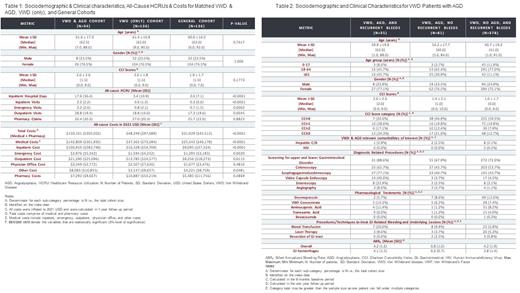Abstract
Background:
Von Willebrand disease (VWD), an autosomal inherited bleeding disorder, is characterized by deficiency or dysfunction of von Willebrand factor (VWF). Patients with VWD may suffer from recurrent bleeding in the gastrointestinal (GI) tract associated with angiodysplasia (AGD). Recurrent hospitalizations due to bleeding are common in patients with VWD and AGD, causing significant financial burden and poor quality of life. There are limited data on the economic and clinical burden of patients with VWD and AGD. This study aims to understand the healthcare resource utilization (HCRU) and economic burden among patients with VWD related AGD from patient and payer perspectives.
Objectives:
To describe the sociodemographic & clinical characteristics, HCRU & all-cause costs (ACC), treatment and procedure patterns for patients with VWD of any type and AGD.
Methods:
This retrospective, observational cohort study used the IBM MarketScan® database (2011-2020), containing healthcare data from the United States (US). Selected patients had ≥1 medical claim for VWD or low VWF, ≥1 medical claim for AGD, and ≥3 GI-related bleed episodes within a year identified using International Classification of Diseases (ICD-9/10) codes. The index date was defined as the date of the first GI bleed-related medical claim before or within 30 days of the first AGD claim. Otherwise, it was defined as the date of the first AGD-related medical claim. Patients were excluded if they did not have 6 months pre- and 12 months post-index continuous enrollment and if they had ≥2 medical claims of hemophilia A (HA), hemophilia B, acquired HA, ulcerative colitis, Crohn's disease, acquired VWD, or other bleeding disorders atleast 30 days apart. HCRU and ACC were compared with a VWD (only) cohort (i.e., continuously enrolled VWD patients without AGD) and a general cohort (i.e., continuously enrolled patients without VWD or AGD) to improve the strength of the evidence via reducing the risk of bias and generating statistical inferences. For comparison of the cohorts, 1:4 exact matching was performed using age, gender, index year, and Charlson Comorbidity Index (CCI) score (relaxing age and index year by ± 5 years). Statistical comparisons were made using ANOVA tests for continuous and Chi-square tests for categorical variables. The ACC were inflated to 2021 US dollars using the annual medical care component of the consumer price index. In addition to the HCRU and ACC comparisons, clinical characteristics of the VWD and AGD cohort were reported along with 2 other cohorts that met 2 of the 3 inclusion criteria to allow for a more relevant description of diagnostics, procedures, and bleed rates.
Results:
After exact matching, 34 patients were selected from the VWD & AGD cohort with 136 patients each from VWD (only) and general population. Mean (SD) HCRU were significantly higher for the VWD & AGD cohort than the VWD (only) and general cohorts: {2.2 (2.2), 0.6 (1.3), and 0.3 (0.6)} inpatient visits, {17.6 (36.4), 3.4 (10.9), and 2.0 (7.1)} inpatient hospital days, {2.2 (2.6), 0.8 (2.1), and 0.7 (1.5)} emergency visits, and {28.8 (19.4), 18.8 (16.0), and 17.3 (19.6)} outpatient visits, respectively. Mean (SD) total ACC were significantly higher for the VWD & AGD cohort than the VWD (only) and general cohorts {$150,101 ($305,052), $48,249 ($97,689), and $31,029 ($45,512), respectively} (Table 1). Sociodemographic and clinical characteristics (e.g. diagnosis related procedures, bleed rates) of the VWD cohort along with the 2 cohorts that met 2 of 3 inclusion criteria are reported in Table 2.
Conclusions:
This study found that patients with VWD and AGD were predominantly female with high HCRU and clinical burden due to recurrent bleeding episodes. The data demonstrated a substantial economic burden, primarily driven by hospitalizations. The diagnostic journey for patients and HCRU is highly variable and may benefit from a more structured and empiric understanding of how VWD and AGD patients are diagnosed and treated. Additionally, costs and burden of VWD & AGD could be mitigated by greater outpatient management to prevent recurrent GI bleeds (i.e. VWF prophylaxis). More research is needed to better understand disease management and healthcare outcomes of patients with VWD and AGD.
Disclosures
Connell:Doximity: Current equity holder in publicly-traded company; Takeda: Consultancy, Membership on an entity's Board of Directors or advisory committees. Caicedo:Takeda: Current Employment, Current holder of stock options in a privately-held company. Nieto:Takeda: Current Employment. Chatterjee:Complete HEOR Solutions: Current Employment, Current equity holder in private company; Takeda: Research Funding. Hait:Complete HEOR Solutions: Current Employment, Current holder of stock options in a privately-held company; Takeda: Research Funding. Bullano:Takeda: Current Employment, Current holder of stock options in a privately-held company. Gupta:Complete HEOR Solutions: Current Employment, Current holder of stock options in a privately-held company; Takeda: Research Funding. Schultz:Takeda: Current Employment, Current holder of stock options in a privately-held company.
Author notes
Asterisk with author names denotes non-ASH members.


This feature is available to Subscribers Only
Sign In or Create an Account Close Modal